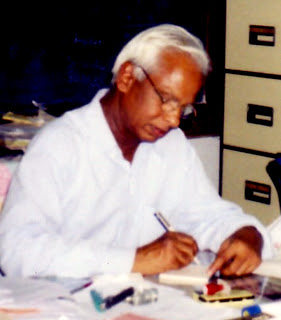Whether the Odia word khiraa derives from the word khiri (Hindi kheer) or not, the two objects, khiraa
and khiri would appear almost alike
to one who has a mind for generalizations, and no mind for specifics. The
careful observer would not make a mistake. Khiraa,
like khiri, it is a sweet dish made
of milk. It is basically sweet, thickened milk, thickened by boiling for a long
time. A considerable amount of home-made cheese or sweet, deep-fried cakes made
of the same (called chenaa taadiaa) are often added to it for taste.
Khiraa does not have the elegant look
of khiri, paayasa, neither does it have its aroma. It hasn’t become a marketable
dish. Not as yet.
Khiraa is a Puri dish; one doesn’t get it in hotels and restaurants
outside this celebrated temple town, which has a history the like of which no
other city or town has in Odisha. “Khiraa”
in the sense of the sweet dish, does not even occur in the exhaustive, three
thousand page dictionary, entitled “Ajanta
Odia Abhidhan”. It is the celebratory sweet dish of “inner” Puri, to be
precise. One could justifiably think of
this temple town in terms of inner Puri and outer Puri. Inner Puri is the old,
traditional town, surrounding the majestic temple, where people mostly connected
with the temple live. Outer Puri is an extension; this is where the “outsiders”
live, government employees, retirees, practitioners of modern professions, etc.
Tourists, as distinct from traditional pilgrims, stay in this part of the town.
In spite of this, inner Puri and outer Puri can be better thought of as are
more cultural than spatial constructs. For the people of outer Puri, generally pitiably
over-conscious about their food, this rather heavy-to-digest khiraa is a at best once-in-a fortnight
dish.
As the celebratory sweet dish, khiraa goes with meals of any kind: rice
and dal, roti or khali roti with dalmaa, puri (also spelt “puree”) and dalmaa or sabji, sweet and spiced,
powdered flat rice (cudaghasa) and dalmaa. People are so fond of it that it
often appears that the main meal is just an excuse for having khiraa. In a feast, when khiraa is served, connoisseurs just set
aside other foods on their leaves (they even fondly ask a friend to do so, if
he hasn’t already) and concentrate on it. If there is rice on the leaf, one
makes a wall of it for khiraa. It has
to be eaten really fast, so that it doesn’t flow out of the leaf. At a feast it
is served at least twice, sometimes even three times, if the host is generous
and the guests, special. One must eat it with one’s fingers, no spoons (and no
cups, either) are provided in a community feast.
Those who simply cannot afford,
go for a substitute – crushed ripe bananas, for example. Those who can barely
afford it have their khiraa rather
thin, with very little cheese or cheese cake in it, or even without either. The
well-to-do have a lot of the same; especially those who love to eat and love to
feed. In a community or group feast, if one is a special guest, one is served
less khiraa and more cheese or cheese
cakes. But one does not necessarily have to be an influential or a powerful
person to be treated as a special guest, especially in inner Puri; here people
still value warmth, goodwill and personal relationship. In a community feast here,
a friend of the host from the outer Puri is also treated as a special guest.
That was how I, a non-entity, used to be treated, when I participated in such a
feast.
Unlike laddu and khiri, and surprisingly rasagola (its
more familiar spelling being rasagulla), it is a completely “secular” dish, that
is, without any traditional ritualistic associations. Without the inviting look of the rasagulla or the
sandesh, and its hard-to-digest reputation, this great cultural dish is
unlikely to attract the uninitiated. Dozens of sweets have found mention in
Odia literature during the last five centuries - ever since the great poet
Sarala – including chenaa tadiaa - but
as for khiraa, the story is different.
It would indeed need research to know if it has been mentioned at all, and if
indeed it has, then whether outside of the context of Puri. With low packaging value, Khiraa is most likely to remain a local dish. Which is fine, as far
as I am concerned: this would make it the ultimate Odia sweet!

1 comment:
i had never heard of this dish. so good to know, and can't wait to try. It is fantastic that you also write about food.
Post a Comment